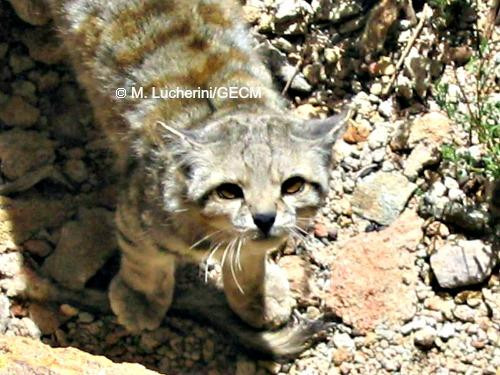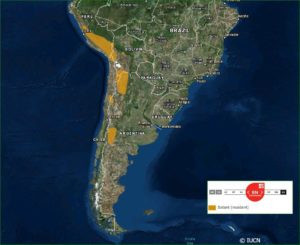 andean-cat-mauro75
andean-cat-mauro75
The Andean cat, scientifically known as Leopardus jacobita, stands as a testament to the wild beauty hidden within the towering Andes Mountains. Often hailed as one of the most captivating wild cat species globally, this creature exhibits a stunning ash grey coat adorned with brown-yellowish blotches. These markings elegantly cascade along its flanks, forming vertical lines that create the illusion of continuous stripes. Its fur is exceptionally dense and plush, a luxurious layer that is incredibly soft and fine, reaching lengths of up to 5 cm along its back. The cat’s underside presents a paler hue, punctuated by dark spots, while prominent dark grey bars accentuate its chest and forelegs. Adding to its distinctive features are the large, rounded ears with dark grey backs and a sleek black nose.
Further down, the legs are patterned with dark, narrower blotches and stripes, though these do not encircle the limbs completely. Its notably large feet bear blackish bars and spots, and are grounded by greyish-brown soles. Perhaps one of its most striking features is its magnificent tail, which is approximately 70% of its head and body length. The tail’s fur is equally long and thick on both the upper and lower sides, giving it a perfectly rounded appearance. Six to nine dark bands ring the tail, culminating in a black tip. This substantial tail likely serves as a crucial balancing aid when navigating its rocky habitat during hunts, and provides essential warmth, allowing the cat to wrap it around its body and tuck its nose within for added insulation when resting.
While there are no discernible differences in fur color between male and female Andean cats, juvenile specimens display lighter coloration and a greater number of smaller blotches. This distinction can lead to confusion with young Pampas Cats (Leopardus colocolo), a related species that shares parts of its range.
Distribution in the High Andes and Beyond
 andean cat range map
andean cat range map
Primarily, the Andean cat’s distribution is concentrated in the high altitudes of the Andes, spanning across Peru and Bolivia, northern Chile, and northern Argentina, reaching elevations up to 5,000 meters. However, recent discoveries have expanded its known range beyond the Andes, with sightings in the Patagonian steppe and scrub habitats at considerably lower altitudes, as low as 650 meters.
A significant finding in 2002 documented an Andean cat and her kitten in a reserve in San Juan province, Argentina, extending their recognized southern distribution by an impressive 500 kilometers. Subsequent field research in 2004 confirmed the presence of these cats in the Andean foothills on the eastern side of the mountain range. These records establish their presence in the scrub habitats of the Patagonian steppe, revealing a more diverse distribution than previously understood. The foothill populations are noted to have a patchy distribution, believed to correlate with the distribution of their primary prey.
Density estimations, conducted in northern Argentina and west-central Bolivia, have yielded figures of 7-12 and 1.8 individuals per 100 km², respectively, highlighting the sparse nature of their populations. The naturally fragmented habitat contributes to potentially large territories and home ranges. Tracking data from a radio-collared female in Bolivia indicated a home range of 65.5 km², while a male in Argentina was recorded at 58.5 km². Camera trapping efforts in Argentina estimated a smaller home range of 40.5 km², suggesting variability based on location and methodology.
Specialized Habitat in Arid Andean Zones
Andean cats exhibit highly specialized habitat preferences, predominantly inhabiting the rocky, arid, and semi-arid regions of the Andes Mountains. The vegetation in these zones is sparse, characterized by small, scattered dwarf shrubs and clumps of bunch grass, interspersed with numerous rocks and boulders. Valleys featuring patchily distributed rock walls are particularly favored habitats. Rock piles and boulders serve as the primary form of shelter at these high altitudes and are also crucial for their main prey species. The Andean cat’s habitat is inherently fragmented, and the uneven distribution of its prey further contributes to a patchy distribution of the cats themselves, resulting in largely unconnected populations.
Ecology and Hunting Habits
The Andean cat’s diet consists of small mammals, birds, waterfowl, and lizards, with a strong reliance on the mountain vizcacha as its primary prey. A recent study in Northwest Argentina revealed that small mammals constituted the majority of their diet (93% of samples). Historically, mountain chinchillas were a significant prey source, but overhunting for their fur has led to their local extinction across much of their range.
The ecological and behavioral aspects of Andean cats remain largely enigmatic. While initial sightings often occurred during daylight hours, contemporary research employing camera traps and radio-collared individuals indicates that they are primarily active during the night, dawn, and dusk hours. This activity pattern is likely synchronized with the feeding habits of their primary prey species, the vizcacha.
Researchers have discovered a greater dependency on vizcachas for Andean cats compared to Pampas cats, which share their habitat. Pampas cats exhibit a more varied diet and are more abundant, even at higher elevations. This interspecies competition for prey could pose a negative impact on Andean cat populations.
Andean cats are typically solitary animals, though they may be observed in pairs or with cubs during the mating season and post-birth period. Local accounts from Bolivia suggest a mating season between July and August, but observations of small cubs in October and April indicate a potentially extended breeding period, possibly stretching until November or December. Beyond this, reproductive biology remains largely unknown, and there are no Andean cats currently in captivity, hindering further study in controlled environments.
Threats to Survival
Several critical threats jeopardize the Andean cat population:
- Habitat Loss and Fragmentation: Extensive mining operations, resource extraction for fuel, agricultural expansion, and inadequate livestock management are leading to the degradation and fragmentation of their fragile habitat.
- Hunting for Spiritual Purposes and Fur: Andean cats are hunted for their fur and as dried, stuffed specimens used in spiritual ceremonies. Indigenous communities consider them sacred, associating them with bountiful harvests, livestock fertility, and the transfer of supernatural power to hunters.
- Hunting for Food and Predator Control: In Peru, they are hunted for food and traditional medicine. In northern Patagonia, they face hunting pressure as perceived predators of small domestic livestock.
- Prey Reduction: Hunting of mountain vizcachas, their primary food source, is causing population declines in this prey species. Vizcachas live in small, patchily distributed colonies and are hunted for both meat and fur.
Conservation Imperative
The Andean cat holds the unfortunate distinction of being the most endangered felid in the Americas. Scientists estimate the total population to be fewer than 1,400 individuals, and numbers are declining. Their distribution overlaps significantly with the historical range of the mountain chinchilla, a species driven to near extinction by the fur trade a century ago. Despite widespread concern regarding the Andean cat’s precarious status, critical data on population structure, essential for effective management plans, remains limited.
Since 1999, the Alianza Gato Andino (Andean Cat Alliance) has been at the forefront of conservation efforts across all range countries. Beyond national conservation initiatives and educational projects focused on protecting the Andean cat and its habitat, multinational collaborations are underway. These concerted efforts are gradually increasing the body of knowledge surrounding this elusive and rare species. In 2004, the Andean Cat Conservation Action Plan was developed, compiling existing information, incorporating local perspectives, and identifying protected areas with confirmed or suspected Andean cat presence. This plan was updated in 2009, further refining threat identification and establishing three key action areas:
- Research: Focusing on completing distribution mapping, defining genetic structure, and establishing a comprehensive conservation status assessment within its range to guide targeted actions against habitat loss and degradation. Expanding the understanding of Andean cat biology, ecology, and conservation threats is paramount.
- Education: Continuing and expanding environmental education activities and community engagement, with a focus on cultivating a supportive environment for conservation actions linked to mountain ecosystem biodiversity and their primary conservation challenges.
- Conservation Management: Promoting environmental management actions aimed at safeguarding critical Andean cat populations, preserving genetic diversity, and ensuring their vital role in the ecological processes within their natural habitat. The current status and population sizes remain poorly understood, emphasizing the urgent need for further research.
Local community involvement stands as the primary strategy for the Andean Cat Alliance. Traditional cultural reverence for the Andean cat offers a foundation for conservation education programs designed to reduce hunting pressures. Furthermore, the maintenance and restoration of mountain vizcacha populations, the Andean cat’s crucial prey, are essential components of its overall conservation.
While the Andean cat benefits from full legal protection at the national level in range countries, effective law enforcement remains challenging. Regrettably, recently hunted specimens have been observed both in the field and offered for sale in specialized markets, highlighting the ongoing threats and the critical need for strengthened conservation measures.
Compare the Andean Cat to the very similar Pampas Cat
Range map IUCN Red List (2018)
Updated 2018
